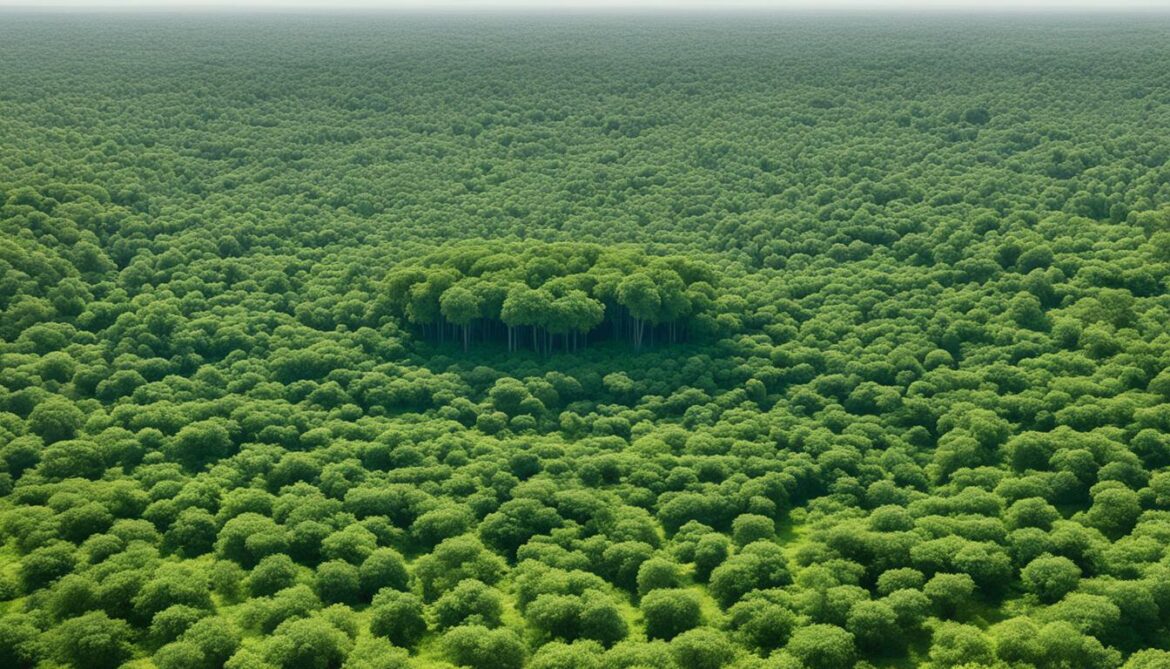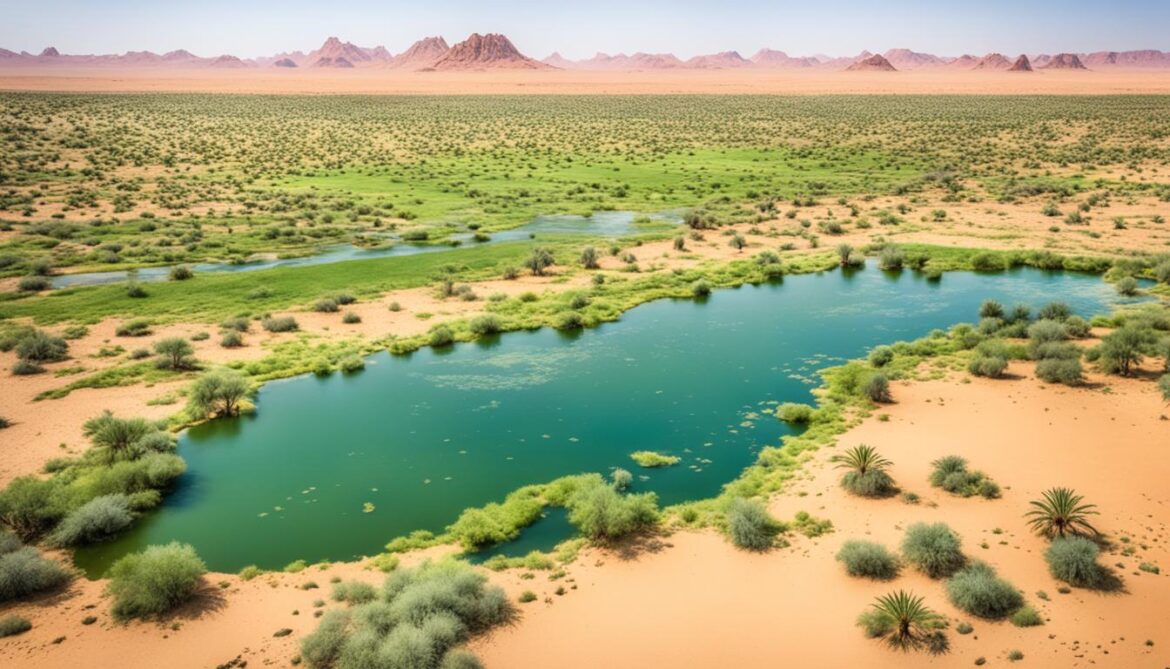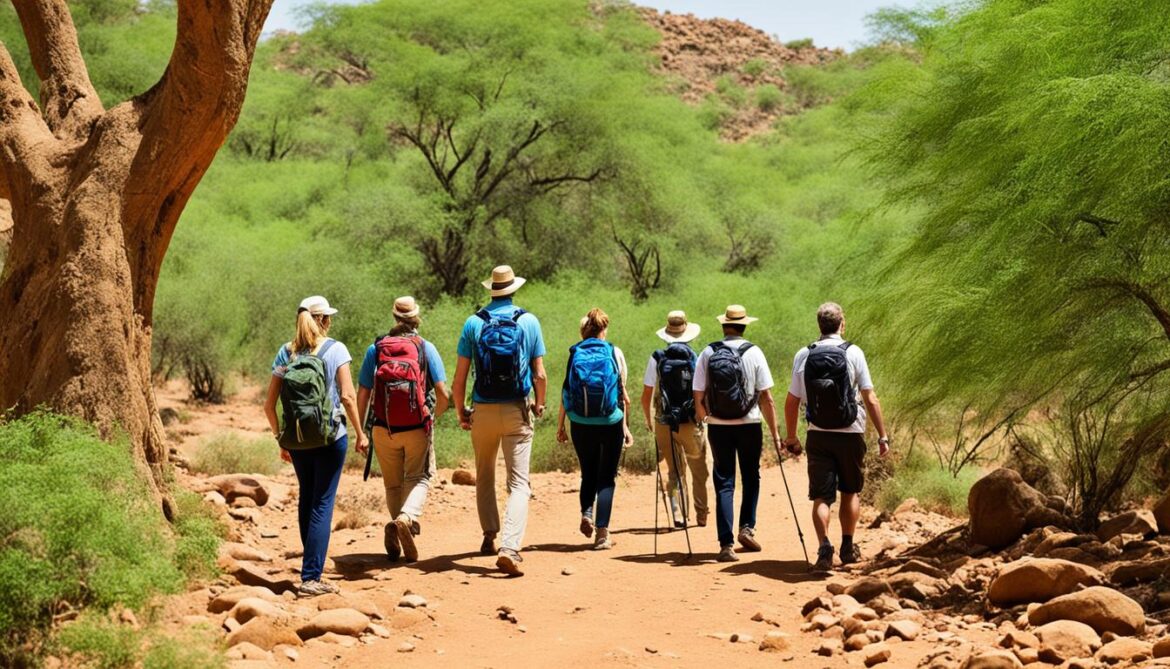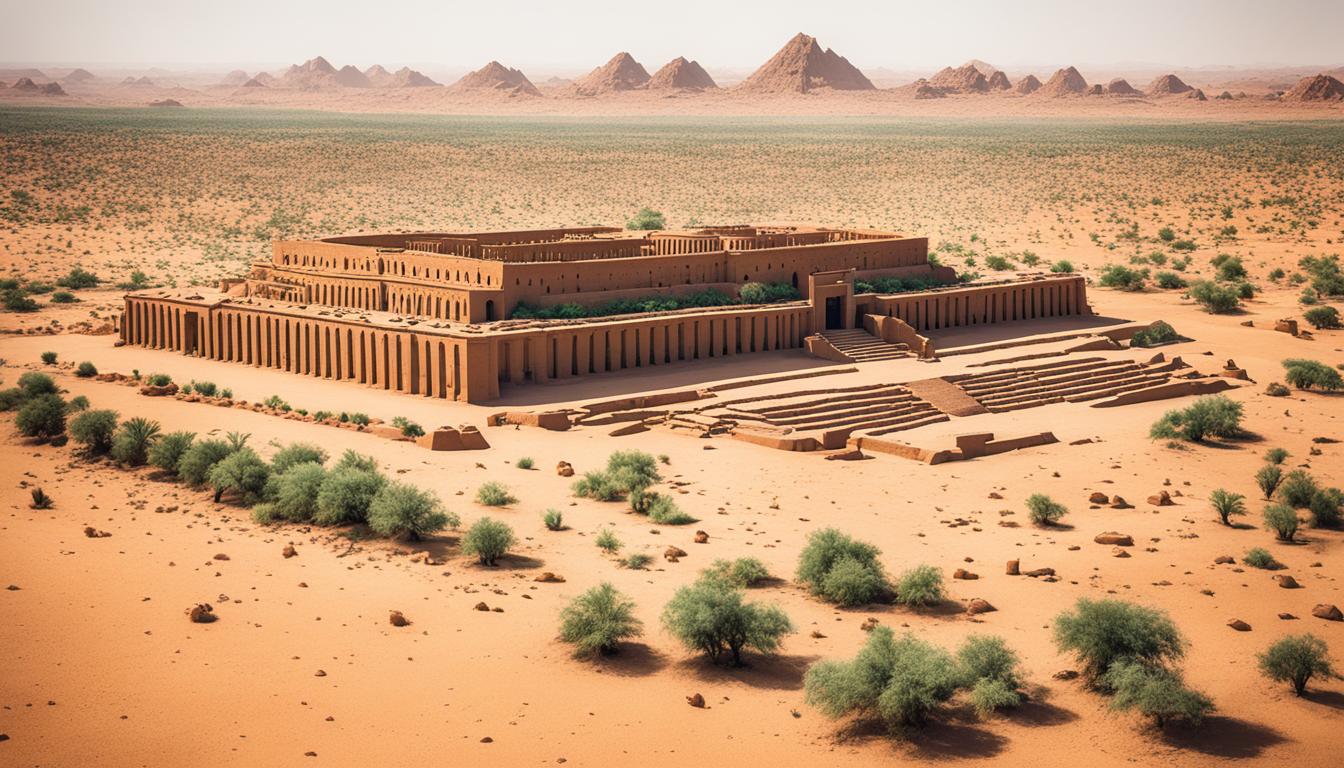Did you know that Sudan, the largest country in Africa, is home to a staggering array of sacred natural sites and rich biodiversity? With its diverse range of ecological zones, including deserts, rainforests, and savannas, Sudan boasts a unique and varied natural heritage that supports countless plant and animal species. However, this biodiversity is under threat from factors such as civil war, drought, over-grazing, and overexploitation of natural resources. Efforts are being made to protect and sustainably manage Sudan’s sacred natural sites and safeguard its incredible ecological diversity.
Key Takeaways:
- Sudan is home to a diverse range of sacred natural sites and rich biodiversity.
- The country’s unique ecological diversity spans deserts, rainforests, and savannas.
- Threats to Sudan’s biodiversity include civil war, drought, and over-exploitation of natural resources.
- Conservation efforts are focused on preserving sacred sites and implementing sustainable management practices.
- Indigenous knowledge and community engagement in conservation play vital roles in protecting Sudan’s natural heritage.
Sudan’s Ecological Diversity
Sudan is a country that boasts incredible ecological diversity. With seven distinct ecological zones, ranging from deserts to rainforests, Sudan showcases a wide variety of natural habitats and species. These ecological zones support a diverse range of vegetation and wildlife, making Sudan a haven for biodiversity.
One of the remarkable features of Sudan’s ecological diversity is the presence of unique range plants like gizzu that thrive in the desert after rare rainfall events. These resilient plants have adapted to survive in arid conditions, showcasing the incredible resilience of Sudan’s flora.
The high rainfall savannas in Sudan are home to a rich array of wildlife populations. Migratory species such as the white-eared kob, tiang, Mongalla gazelle, and Red-fronted gazelle can be found in these savannas, adding to the ecological richness of the region.
Sudan also boasts internationally recognized wetlands and coastal ecosystems, such as the Sudd and the Red Sea. These areas serve as important habitats for migratory waterfowl and support a diverse marine biodiversity. The wetlands provide critical nesting and feeding grounds for a wide variety of avian species, contributing to the country’s ecological significance.
Overall, Sudan’s ecological diversity is a testament to its rich natural heritage. The country’s unique mix of ecological zones, vegetation types, and diverse wildlife populations make it a fascinating destination for nature enthusiasts and conservationists alike.
| Ecological Zones |
Vegetation |
Wildlife |
| Deserts |
Gizzu and other desert-adapted plants |
Camels, desert foxes, sand gazelles |
| Savannas |
Grasses, acacia trees |
White-eared kob, tiang, Mongalla gazelle, Red-fronted gazelle |
| Rainforests |
Tall trees, dense undergrowth |
Chimpanzees, gorillas, African elephants |
| Wetlands |
Aquatic plants, reeds |
Migratory waterfowl, crocodiles, hippos |
| Coastal Ecosystems |
Mangroves, seagrass beds |
Coral reefs, marine turtles, dolphins |
Importance of Sacred Groves in Sudan
Sacred groves hold immense cultural and spiritual significance in Sudan. They are seen as the first temples of God and are considered manifestations of spiritual powers and connections to ancestors.
These sacred sites are managed by local communities through the employment of sanctions and traditional conservation practices. The Ramogi sacred forest, for example, is managed by the local community with the support of national institutions like Kenya Forestry Research Institute (KEFRI) and the National Museums of Kenya.
Believed to be the site where the patriarch of the Luo ethnic group established the first fortified settlement, the Ramogi sacred forest serves as a testament to Sudan’s rich cultural heritage and traditional conservation practices.
Spiritual Significance of Sacred Groves
Sacred groves are deeply rooted in the spiritual beliefs and practices of the local communities. They serve as spaces for worship, rituals, and ceremonies, fostering a strong connection between the people and their ancestors. These groves are believed to be inhabited by spirits or deities, and their presence is seen as a source of blessings, guidance, and protection.
“Sacred groves are the sanctuaries that connect us to our ancestral spirits. They are sacred spaces where we seek spiritual solace and receive divine messages.” – Elder from the local community
Through the preservation and protection of sacred groves, Sudanese communities aim to maintain their cultural and spiritual heritage for future generations.
Traditional Conservation Practices
Sudanese communities have developed traditional conservation practices that have been passed down through generations. These practices, rooted in cultural and spiritual values, aim to sustainably manage the natural resources found within sacred groves.
- Sustainable Harvesting: Local communities practice selective harvesting of natural resources, ensuring the regeneration and long-term availability of essential plants.
- Seasonal Restrictions: Certain areas of the sacred groves are designated as off-limits during specific seasons to allow for natural regeneration and protect sensitive habitats.
- Community Governance: The management of sacred groves is entrusted to community leaders and elders who enforce rules and regulations to prevent overexploitation and maintain the integrity of the sites.
By adhering to these traditional conservation practices, Sudanese communities demonstrate their commitment to preserving the ecological balance and cultural significance of the sacred groves.

Preservation of Cultural Heritage
The conservation of sacred groves in Sudan contributes to the preservation of the country’s cultural heritage. These groves encapsulate the traditional knowledge, customs, and beliefs of local communities, serving as living museums that showcase the rich history and cultural diversity of Sudan.
By protecting and promoting the cultural heritage associated with sacred groves, Sudanese communities ensure the continuity of their unique practices, strengthening their sense of identity and belonging.
Overall, the importance of sacred groves in Sudan extends beyond their ecological significance. They are symbols of cultural resilience, spiritual connection, and traditional conservation practices that have sustained both natural and cultural heritage for centuries.
| Benefits of Sacred Groves in Sudan |
Conservation Practices |
| – Spiritual and cultural significance |
– Sustainable harvesting |
| – Preservation of ancestral connections |
– Seasonal restrictions |
| – Community identity and heritage |
– Community governance |
Threats to Sudan’s Biodiversity
Sudan’s biodiversity faces numerous threats that pose challenges to its preservation. These include the impact of civil wars, drought in arid and semi-arid zones, over-grazing, imprudent use of natural resources, socio-economic factors, expansion of mono-crop agriculture, poaching, and forest degradation.
Mangrove stands in Sudan are particularly affected by camel grazing and felling, leading to habitat loss and forest degradation. Additionally, riverain forests experience the dieback of Sunt trees, contributing to *habitat loss* and further forest degradation.
The consequences of these threats are evident in the decline of wildlife populations in terms of both numbers and diversity. Furthermore, important fisheries species have become vulnerable to over-fishing, putting their populations at risk.
Population migration from rural areas to cities has resulted in the habitat loss and degradation of resources, leading to a decline in agricultural biodiversity. This loss of biodiversity not only impacts the environment but also affects the livelihoods and well-being of local communities.
Addressing these threats is crucial to ensure the sustainable conservation of Sudan’s biodiversity and ecosystem. Efforts must be made to promote effective habitat protection, implement sustainable resource management practices, and enforce regulations against poaching and forest degradation. Collaborative initiatives involving local communities, government agencies, and conservation organizations are key to combatting these threats and preserving Sudan’s unique biodiversity.

| Threats |
Impact |
| Civil Wars |
Disruption of ecosystems, loss of habitat |
| Drought |
Loss of plant and animal species, degradation of ecosystems |
| Over-grazing |
Habitat degradation, loss of plant diversity |
| Poaching |
Decline in wildlife populations, imbalance in ecosystems |
| Forest Degradation |
Loss of habitat, disruption of ecological balance |
| Habitat Loss |
Decline in biodiversity, threats to endangered species |
Conservation Efforts in Sudan
Sudan has taken significant steps to conserve its biodiversity and protect its sacred natural sites. The country has developed a comprehensive National Biodiversity Strategy and Action Plan (NBSAP) that encompasses various conservation measures and sustainable management practices.
One of the key focuses of Sudan’s NBSAP is to enhance scientific knowledge and research on agricultural biodiversity and forestry. This scientific foundation provides valuable insights into the unique ecosystems and species found in Sudan, enabling better conservation and management strategies to be implemented.
The establishment of protected areas, such as Dinder National Park and the Ramogi sacred forest, has played a vital role in safeguarding biodiversity and raising awareness among neighboring communities. These protected areas provide habitats for diverse plant and animal species, promoting the ecological balance and supporting sustainable development.
Community-Based Conservation
Community engagement is crucial to the success of biodiversity conservation in Sudan. Community-based organizations and village development committees have been formed to actively manage conservation activities on behalf of the community. These initiatives empower local communities to take ownership of the natural resources and actively participate in conservation efforts.
Alternative livelihood models are being implemented to support communities living near protected areas. By promoting sustainable income-generating activities, such as eco-tourism and sustainable resource use, these initiatives provide economic benefits to local communities while fostering a sense of responsibility towards biodiversity conservation.
Forest Conservation Policies
Forest conservation policies are being developed in Sudan to strengthen the capacity of local communities and support their cultural and religious practices related to natural resource management. These policies aim to strike a balance between the conservation of forests and the utilization of their resources.
Efforts are being made to enhance capacity building programs to equip local communities with the necessary skills and knowledge to manage forests sustainably. Cultural and religious considerations are taken into account to ensure that conservation practices align with the traditional practices and beliefs of the communities.
In addition, the government is working towards increasing the visibility of conservation areas to promote their importance among the general public. By raising awareness, Sudan aims to cultivate a culture of biodiversity conservation and encourage the active participation of its citizens in protecting the country’s natural heritage.

In conclusion, Sudan’s conservation efforts demonstrate a commitment to preserving its unique biodiversity and sacred natural sites. Through the implementation of the National Biodiversity Strategy and Action Plan, the establishment of protected areas, and the promotion of community-based conservation, Sudan is working towards the sustainable management of its natural resources. By integrating cultural and religious practices into forest conservation policies and fostering community engagement, Sudan strives to create a harmonious balance between human development and environmental conservation.
Role of Indigenous Knowledge in Natural Resource Management
Indigenous knowledge and cultural practices are indispensable in the conservation and sustainable management of Sudan’s natural resources. The deep understanding and wisdom of traditional healers and local communities contribute significantly to the protection and preservation of sacred groves and their biodiversity.
For centuries, traditional healers have relied on their extensive knowledge of the forest to gather medicinal plants and herbs. They play a vital role in the sustainable utilization of natural resources, visiting the sacred groves for pilgrimage and restocking their inventory of rare medications derived from the forest’s flora. Their expertise not only benefits the health and well-being of individuals but also supports the conservation of Sudan’s unique biodiversity.
The local people have their own rules and regulations to safeguard the sacred areas within the forest.
One example of effective conservation practices can be found in the Got Ramogi forest. The existence of a council of elders ensures the conservation and regulation of resource utilization within the forest. Through traditional governance systems, the local community has established rules and regulations to protect the sacred areas, preventing overexploitation and maintaining the ecological balance of the forest.
To ensure the long-term protection and sustainable management of Sudan’s natural resources, it is crucial for policies to recognize and respect the rights of indigenous communities to forest resources. Indigenous communities possess a wealth of knowledge about their environment, passed down through generations, that can significantly contribute to biodiversity conservation.
Recognizing the cultural values embedded in indigenous knowledge systems and integrating them with modern conservation approaches can enhance both the effectiveness and inclusivity of conservation efforts. By combining traditional practices with scientific knowledge, Sudan can strike a balance between cultural preservation, ecological sustainability, and socioeconomic development.
Benefits of Indigenous Knowledge in Biodiversity Conservation:
- Preserving traditional ecological knowledge
- Enhancing sustainable resource management
- Promoting cultural values in biodiversity conservation
- Fostering community engagement and ownership
- Enriching conservation strategies with local expertise
It is crucial to acknowledge the invaluable contribution of indigenous knowledge and ensure that the rights and cultural values of indigenous communities are respected and protected. By harnessing the power of traditional conservation practices and involving local communities in decision-making processes, Sudan can promote biodiversity conservation that aligns with cultural heritage preservation and sustainable development goals.

| Key Points |
Importance |
| Preservation of sacred groves and their biodiversity |
Avoidance of overexploitation and ecological imbalances |
| Integration of traditional practices with modern conservation approaches |
Inclusivity and effectiveness in biodiversity conservation |
| Recognition of indigenous rights to forest resources |
Preservation of cultural heritage and traditional knowledge systems |
| Enhancement of sustainable resource management |
Long-term conservation and socioeconomic development |
Community Engagement in Forest Conservation
Local communities in Sudan are actively involved in community-led conservation initiatives, demonstrating their commitment to preserving and sustainably utilizing forest resources. These initiatives include the introduction of energy-saving stoves, which not only reduce the dependence on unsustainable fuel sources but also contribute to mitigating climate change.
The local communities are also actively engaged in raising community awareness about the importance of forest conservation and sustainable resource use. Through community awareness programs, they educate their members about the ecological value of forests and the need for responsible resource management.
“Our forests are our lifeline. They provide us with clean air, fresh water, and a source of livelihood. It is our responsibility to protect and preserve them for future generations.” – Community member
Recognizing the significance of forests as a source of income, the local communities have established nurseries to replenish the forest cover and promote sustainable forest management. They cultivate and nurture tree saplings, ensuring a constant supply of timber, fuelwood, and other forest products without depleting natural resources.
In addition, the communities have also initiated income-generating activities that rely on sustainable resource use. For example, they engage in eco-tourism ventures in areas with sacred groves, creating opportunities for visitors to experience Sudan’s rich biodiversity while generating economic benefits for the local communities. This not only helps diversify their income sources but also raises awareness about the importance of biodiversity conservation and fosters an appreciation for Sudan’s natural heritage.
Sustainable Resource Use and Community-led Conservation Initiatives
- Energy-saving stoves reduce the reliance on unsustainable fuel sources.
- Community awareness programs raise understanding of forest conservation.
- Nurseries promote sustainable forest management and replenish forest cover.
- Income-generating activities, such as eco-tourism, provide economic benefits.
The community’s active engagement in forest conservation can be attributed to their deep cultural and religious attachment to the forest. Forests are seen as sacred and vital to their way of life, inspiring a strong sense of responsibility and stewardship.
By actively participating in community-led conservation initiatives, the local communities in Sudan are playing a crucial role in ensuring the sustainable use of forest resources and the long-term preservation of Sudan’s natural heritage.

Through their efforts, they are not only safeguarding the ecological integrity of these forests but also creating a sustainable future for themselves and future generations.
Government’s Role in Forest Conservation
The government of Sudan plays a critical role in the conservation of its forests. It is crucial for the government to develop and implement effective forest conservation policies that prioritize sustainable forest management. Through these policies, the government can ensure the long-term preservation of Sudan’s forest resources.
One important aspect of forest conservation is capacity building. The government should invest in training programs and workshops to enhance the knowledge and skills of local communities and institutions involved in conservation efforts. By equipping individuals with the necessary tools and expertise, they can effectively contribute to the sustainable management of Sudan’s forests.
Furthermore, the government should recognize and support the cultural and religious resources present in forested areas. By understanding the cultural and religious significance of these resources, the government can integrate them into conservation practices, fostering a holistic approach to forest management in Sudan.
Efforts should also be made to increase the visibility of conservation areas. By raising awareness and promoting the importance of forest conservation, the government can garner public support and participation in conservation efforts. This can be done through educational campaigns, community engagement programs, and the establishment of visitor centers to showcase the value of Sudan’s forests.
To ensure the sustainable utilization of forest resources, collaboration between government agencies, research institutes, and local communities is essential. By working together, these stakeholders can develop effective strategies for forest conservation and management, promoting the long-term well-being of both the forests and the communities that depend on them.

| Initiative |
Objective |
Outcome |
| Development of forest conservation policies |
Prioritize sustainable forest management |
Enhanced protection and preservation of forest resources |
| Capacity building programs |
Enhance knowledge and skills of stakeholders |
Empowered local communities and institutions in forest conservation |
| Inclusion of cultural and religious resources in conservation practices |
Recognize and support cultural and religious significance |
Integration of holistic approaches in forest management |
| Increased visibility of conservation areas |
Raise awareness and promote forest conservation |
Public support and active participation in conservation efforts |
| Collaboration between stakeholders |
Government agencies, research institutes, and local communities |
Effective strategies for forest conservation and sustainable management |
Sustainable Utilization of Biodiversity Resources
Sustainable resource management is key to the long-term preservation of Sudan’s diverse ecosystems and the well-being of local communities. One of the valuable resources that can be sustainably utilized is traditional medicinal plants, often found in sacred groves. These plants have been used for centuries by local communities for their healing properties and can contribute to supporting health and livelihoods.
Exploring income generation opportunities from biodiversity resources can also provide economic benefits to the local community while ensuring the conservation of valuable plant species. Aloe species, in particular, are abundant in Sudan and have various applications in industries such as cosmetics, pharmaceuticals, and food. By ethically and sustainably harvesting these Aloe species, communities can generate income while preserving biodiversity.
It is crucial to promote sustainable resource management practices that strike a balance between the needs of local communities and the conservation of Sudan’s biodiversity. This includes adopting harvesting techniques that limit ecological impact, implementing replanting programs to ensure resource regeneration, and fostering community-led initiatives for responsible resource utilization.
| Biodiversity Resource |
Potential Applications |
| Traditional Medicinal Plants |
– Natural remedies for various health issues |
| Aloe Species |
– Cosmetics, pharmaceuticals, food industry |
By harnessing the potential of Sudan’s biodiversity resources and implementing sustainable practices, we can ensure the longevity of these valuable ecosystems and contribute to the socio-economic development of local communities.

Testimonial: The Importance of Sustainable Use
“Sustainable utilization of biodiversity resources is not only beneficial for the environment and economy but also for the cultural and spiritual well-being of our community. By carefully managing our natural resources, we ensure the preservation of our cultural heritage while improving our livelihoods.”
Dr. Ahmed Khalid, Traditional Medicine Practitioner
Conclusion
Sudan’s sacred natural sites and biodiversity hold immense cultural and ecological value. It is crucial to preserve these sites and manage resources sustainably for the well-being of local communities and the long-term conservation of Sudan’s natural heritage. Enhancing conservation practices, engaging communities, and integrating traditional knowledge with modern approaches are vital for the success of biodiversity conservation in Sudan.
By recognizing the cultural, spiritual, and economic significance of sacred groves and supporting community-led conservation initiatives, Sudan can ensure the preservation of its unique natural sites and the protection of its diverse biodiversity for future generations.
Efforts to conserve Sudan’s biodiversity and sacred natural sites are an integral part of sustainable resource management. Through collective action and collaboration between stakeholders, Sudan can continue its journey towards an environmentally sustainable future.
FAQ
What is the significance of sacred groves in Sudan?
Sacred groves in Sudan are seen as the first temples of God and are considered manifestations of spiritual powers and connections to ancestors. They play a vital role in preserving Sudan’s cultural heritage and traditional conservation practices.
What are the threats to Sudan’s biodiversity?
Sudan’s biodiversity faces threats from factors such as civil war, drought, over-grazing, overexploitation of natural resources, poaching, and forest degradation.
What conservation efforts are being made in Sudan?
Sudan has implemented various measures to protect its biodiversity, including the establishment of protected areas, development of forest conservation policies, and the formation of community-based organizations to manage conservation activities.
How does indigenous knowledge contribute to natural resource management in Sudan?
Indigenous knowledge and cultural practices play a significant role in the conservation of Sudan’s natural resources. Traditional healers and communities with deep knowledge of the forest contribute to the sustainable management of sacred groves.
What role do local communities play in forest conservation in Sudan?
Local communities in Sudan are actively engaged in forest conservation and sustainable resource use through community-led conservation initiatives, awareness programs, establishment of nurseries, and income-generating activities.
What is the government’s role in forest conservation in Sudan?
The government plays a crucial role in forest conservation in Sudan through the development of forest conservation policies, capacity building, and supporting the cultural and religious practices of local communities in conservation efforts.
How can biodiversity resources in Sudan be sustainably utilized?
Sustainable utilization of biodiversity resources in Sudan can be achieved through practices such as the sustainable harvesting of traditional medicinal plants, exploring income generation opportunities from biodiversity resources, and promoting sustainable resource management.
What is the importance of preserving Sudan’s natural heritage?
The preservation of Sudan’s sacred natural sites and biodiversity is crucial for the well-being of local communities and the long-term conservation of Sudan’s cultural and ecological diversity.
Source Links

























Post comments (0)